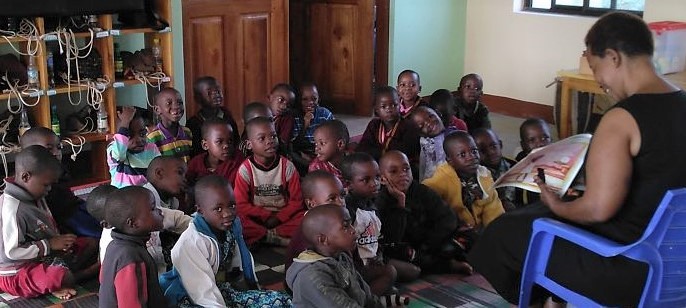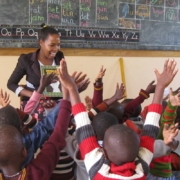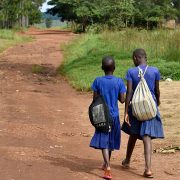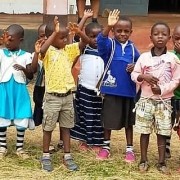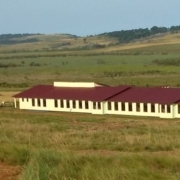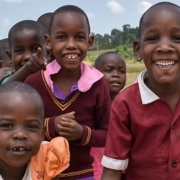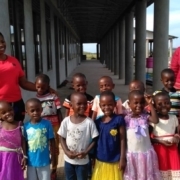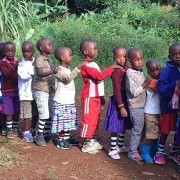A First-Grader’s Day at School
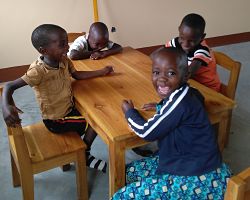 Going from kindergarten to first grade is a big step for Twegashe’s first class of students—being in school from 8 am to 4 pm, sitting at tables instead of on mats on the floor as they are accustomed to doing at home, eating lunch at school, learning to get along with twenty-nine classmates instead of fourteen, helping new kindergartners learn the ropes. It’s fun to see how comfortable and confident these first-graders are now. They walk with a bounce in their step – a big contrast to the timid and hesitant new kindergartners. But we know it’s only a matter of time before the kindergartners will have that bounce, too!
Going from kindergarten to first grade is a big step for Twegashe’s first class of students—being in school from 8 am to 4 pm, sitting at tables instead of on mats on the floor as they are accustomed to doing at home, eating lunch at school, learning to get along with twenty-nine classmates instead of fourteen, helping new kindergartners learn the ropes. It’s fun to see how comfortable and confident these first-graders are now. They walk with a bounce in their step – a big contrast to the timid and hesitant new kindergartners. But we know it’s only a matter of time before the kindergartners will have that bounce, too!
Here’s what a typical day is like for a first-grader at Twegashe School…
Getting there
After a walk of 30 to 45 minutes, depending on where they live in the village, children arrive at school around 7:45. Of course, none of them have watches, so it’s hard for them to know if they need to hurry. All of the children come unaccompanied (It’s very common here for children as young as kindergarten to walk along the road to school without any adult supervision, even along the main road to town). Madam Editha gives them many warnings to be careful on the village road leading to Twegashe School, since the motorcycle drivers who ferry passengers out to the main road often go much too fast for safety. Unfortunately, there are no speed limits on little roads like this (and no police out here to enforce them if there were!)
Opening activities
Class begins at 8:00, and the first activity for the first-graders is helping to sweep their classroom. Everyone must remove their shoes before entering the classroom, so it’s important to keep the floors clean. After cleaning, it’s opening circle and story time. The children listen attentively as Madam Editha reads a story book in English (with some translating to make sure they can follow the story). These children have no books at home, and they relish this time hearing these fun stories and looking at the colorful pictures.
Porridge time
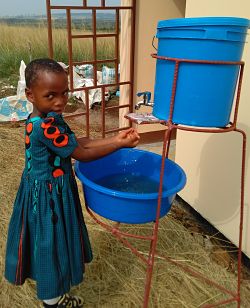 At 8:40 the children wash their hands at the “corona bucket” outside their classroom, preparing to go to the cafeteria for porridge. Ever since the COVID-19 outbreak in Tanzania back in March 2020, all businesses are required to have a handwashing station outside their establishment. The station is usually a simple stand made from bent and welded rebar. The stand holds a large bucket in which a plastic or metal tap has been inserted. Occasionally in town you’ll see a fancier version with a foot pedal to turn on the water. We even saw one with a foot pedal to operate the plastic liquid soap dispenser!
At 8:40 the children wash their hands at the “corona bucket” outside their classroom, preparing to go to the cafeteria for porridge. Ever since the COVID-19 outbreak in Tanzania back in March 2020, all businesses are required to have a handwashing station outside their establishment. The station is usually a simple stand made from bent and welded rebar. The stand holds a large bucket in which a plastic or metal tap has been inserted. Occasionally in town you’ll see a fancier version with a foot pedal to turn on the water. We even saw one with a foot pedal to operate the plastic liquid soap dispenser!
We’ve outgrown the kitchen as an eating place, so this year the first-graders sit on tarps on the cafeteria floor together with the morning kindergartners. Porridge time is surprisingly quiet. Traditionally, children are not supposed to talk at meals, and our teachers have been enforcing this tradition. But they do occasionally use the opportunity to practice language relevant to the context of eating. First-graders also help model polite language to the kindergartners: “Madam, may I please have more porridge?”
 After porridge it’s bathroom break. Porridge here is normally thin (drunk from a cup, not eaten with a spoon), so without a bathroom break after porridge there will be many interruptions of “Madam, may I please go out?” In fact, even with a bathroom break there are still many of these interruptions! To go to the bathroom, students slip on one of the thirty pairs of school plastic sandals lined up outside their classroom next to all of their shoes. This saves time as there is no need for struggling with shoestrings, Velcro, and another common problem – shoes that are too tight!
After porridge it’s bathroom break. Porridge here is normally thin (drunk from a cup, not eaten with a spoon), so without a bathroom break after porridge there will be many interruptions of “Madam, may I please go out?” In fact, even with a bathroom break there are still many of these interruptions! To go to the bathroom, students slip on one of the thirty pairs of school plastic sandals lined up outside their classroom next to all of their shoes. This saves time as there is no need for struggling with shoestrings, Velcro, and another common problem – shoes that are too tight!
Morning lessons
After break, the first-graders continue with lessons until lunchtime. The first-graders are not doing Montessori anymore as they did in kindergarten, except for a few special, more advanced activities. But Madam Editha tries to use hands-on activities as much as possible. For example, this week they are practicing forming letters out of modeling clay. The children are not at all used to having these sorts of materials, so hands-on activity time is always very exciting!
Lunch
 At 11:40 the morning kindergartners go home and the first-graders head to the cafeteria for lunch (after washing hands again, of course.) Lunch is stiff corn flour mush (similar to polenta), cooked dried beans, and some kind of greens or other vegetable. Two days a week, instead of beans the menu is a soup of “dagaa” – tiny dried fish that are sold by the handful. Not particularly tasty to this outsider but cheap, easy to store, and a good source of protein.
At 11:40 the morning kindergartners go home and the first-graders head to the cafeteria for lunch (after washing hands again, of course.) Lunch is stiff corn flour mush (similar to polenta), cooked dried beans, and some kind of greens or other vegetable. Two days a week, instead of beans the menu is a soup of “dagaa” – tiny dried fish that are sold by the handful. Not particularly tasty to this outsider but cheap, easy to store, and a good source of protein.
 As a vegetable we’ve been having lots of cabbage lately since it’s easy to find at the little kiosk shops in the village. But we’re planning to grow our own vegetables so the children can have a greater variety of greens. We’ve enlisted a few women to clear a school garden, and we’ve got spinach, Chinese cabbage, Swiss chard, and collard green seeds at the ready!
As a vegetable we’ve been having lots of cabbage lately since it’s easy to find at the little kiosk shops in the village. But we’re planning to grow our own vegetables so the children can have a greater variety of greens. We’ve enlisted a few women to clear a school garden, and we’ve got spinach, Chinese cabbage, Swiss chard, and collard green seeds at the ready!
When the students finish eating, they scrape their leftovers into a bucket and put their dishes in the big cookpot to be washed. After being sure to thank the cook, they have the remainder of the lunch hour to either do silent (“Ahem!”) reading in the classroom or play outside (weather permitting). Right now the teacher or whoever happens to be free at this time supervises the children, but we’ll soon be hiring a “matron” to take over this role, along with a bunch of other tasks at school. The teachers are busy with the students from 8am to 4pm, so we know they need that hour-long break to themselves!
Afternoon lessons
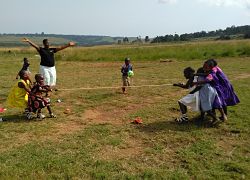 Lessons continue until 4pm, with breaks for things like “heads-down” rest time, library time, and outdoor play. The children especially love outdoor play time. In fact, it’s often hard to contain their excitement when they get hold of a ball or a jump rope, or even each other when a game of tag turns into tackle! It’s not surprising that they are eager to run around outside, since before they start school that’s what most village kids do for much of the day, usually without any adult supervision. The long Twegashe corridor outside the classrooms is a temptation for running, but they’re gradually getting the message that the corridor is a “No running” zone!
Lessons continue until 4pm, with breaks for things like “heads-down” rest time, library time, and outdoor play. The children especially love outdoor play time. In fact, it’s often hard to contain their excitement when they get hold of a ball or a jump rope, or even each other when a game of tag turns into tackle! It’s not surprising that they are eager to run around outside, since before they start school that’s what most village kids do for much of the day, usually without any adult supervision. The long Twegashe corridor outside the classrooms is a temptation for running, but they’re gradually getting the message that the corridor is a “No running” zone!
 The day usually ends with music. Sometimes singing songs, sometimes drumming and dancing. This is another favorite activity for most children. They end the day happy and energized for the trip home. “Bye bye, Madam!”, “Bye bye, children! See you tomorrow.” And then, as soon as they leave the corridor and hit the grass they break into a run up the hill toward their homes!
The day usually ends with music. Sometimes singing songs, sometimes drumming and dancing. This is another favorite activity for most children. They end the day happy and energized for the trip home. “Bye bye, Madam!”, “Bye bye, children! See you tomorrow.” And then, as soon as they leave the corridor and hit the grass they break into a run up the hill toward their homes!

